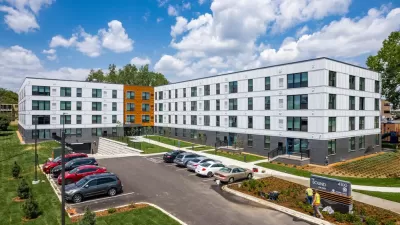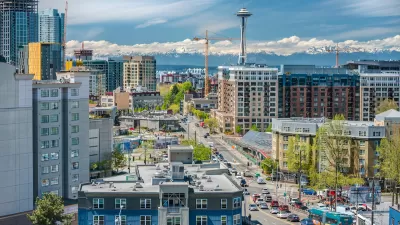A high-stakes, high-profile community land trust project once hailed as a triumph in New Orleans ended in disaster for its residents, but it’s important to draw the right lessons about why.

In December 2022, Doratha “Dodie” Smith-Simmons and her husband, John, were once again facing eviction. Their rent-restricted New Orleans apartment in the recently renovated Pythian Building was reverting to market rate.
Smith-Simmons is an almost-lifelong New Orleanian. She’s a well-known civil rights activist, was at the March on Washington, joined the local chapter of the Congress of Racial Equality in 1961, and was a founding member of the New Orleans Jazz & Heritage Festival. She’s lived—and rented—in the city much of her life. Housing used to be affordable, she says, but “in recent years, due to Hurricane Katrina and gentrification, the price has gone through the roof.”
Rent and fees already amount to “$845 that I could barely afford to pay,” Smith-Simmons says. “Our only source of income is Social Security checks . . . with very little left over after paying the rest of my bills.” The increase to $1,535 per month would mean she and John would have to move—again.
This wasn’t the first time a rent hike threatened to displace the Smith-Simmonses. The couple, who are now in their 80s, got a similar eviction notice in late 2016 when the American Can Complex (known as the Can) went market rate. The Can had been renovated 15 years earlier using a mishmash of historic tax credits and state- and city-funded tax-exempt bond financing that required 20 percent of the units be reserved for low-income renters for 15 years. When the affordability period lapsed, the owners allowed all 53 of the Can’s rent-restricted units to revert to market rate. The Smith-Simmonses’ rent would have jumped from $750 to more than $1,200 a month plus fees. They, and the rest of the Can’s low-income tenants, had to move or absorb a large increase in their rent.
Getting kicked out of the Can was traumatic, but getting a rent-increase notice from the Pythian was even more jarring. While the Can’s affordability was temporary from the start, the Pythian’s developers had explicitly promised “permanent affordability,” no matter how much time passed or how many times the building changed hands.
In fact, it was the Pythian’s developers who gave some of the Can’s low-income residents a place to go in early 2017. Just before they were supposed to move out, several low-income Can residents got letters from the Pythian’s owner-developer. Smith-Simmons still has hers. “The Pythian is a mixed-income, mixed-use development at 234 Loyola Avenue, currently in renovation, that will be available for residential rental by April 1, 2017. Our building is unique in that it will have 25 units of permanently affordable housing. That means there will be no threat of eviction,” it reads.
Getting that letter “was such a joyous thing,” Smith-Simmons says. “‘Permanently affordable housing’ is underlined,” she says after reading the letter aloud. “That’s what motivated us to move here.”
But just four years after the Smith-Simmonses moved into the Pythian, they found themselves facing a de facto eviction once again. The limited liability company (LLC) that owned the Pythian had gone from three partners to one, and the remaining owner planned to discontinue offering “income-based units.” If the building’s low-income tenants wanted to renew their lease in March 2023, they’d have to pay market rate.
The Pythian’s owner backtracked following a local media outcry. As of this story’s publication, the tenants of the 25 income-based units were on month-to-month leases at their previous rent amounts. But they’ve got no assurance of how long that will last. The promise of permanent affordability, and the residents’ hope for a permanent home, have vanished.
FULL STORY: The Permanent Affordability That Wasn’t: Lessons from the Pythian Building

Planetizen Federal Action Tracker
A weekly monitor of how Trump’s orders and actions are impacting planners and planning in America.

San Francisco's School District Spent $105M To Build Affordable Housing for Teachers — And That's Just the Beginning
SFUSD joins a growing list of school districts using their land holdings to address housing affordability challenges faced by their own employees.

The Tiny, Adorable $7,000 Car Turning Japan Onto EVs
The single seat Mibot charges from a regular plug as quickly as an iPad, and is about half the price of an average EV.

With Protected Lanes, 460% More People Commute by Bike
For those needing more ammo, more data proving what we already knew is here.

In More Metros Than You’d Think, Suburbs are Now More Expensive Than the City
If you're moving to the burbs to save on square footage, data shows you should think again.

The States Losing Rural Delivery Rooms at an Alarming Pace
In some states, as few as 9% of rural hospitals still deliver babies. As a result, rising pre-term births, no adequate pre-term care and "harrowing" close calls are a growing reality.
Urban Design for Planners 1: Software Tools
This six-course series explores essential urban design concepts using open source software and equips planners with the tools they need to participate fully in the urban design process.
Planning for Universal Design
Learn the tools for implementing Universal Design in planning regulations.
Smith Gee Studio
City of Charlotte
City of Camden Redevelopment Agency
City of Astoria
Transportation Research & Education Center (TREC) at Portland State University
US High Speed Rail Association
City of Camden Redevelopment Agency
Municipality of Princeton (NJ)





























